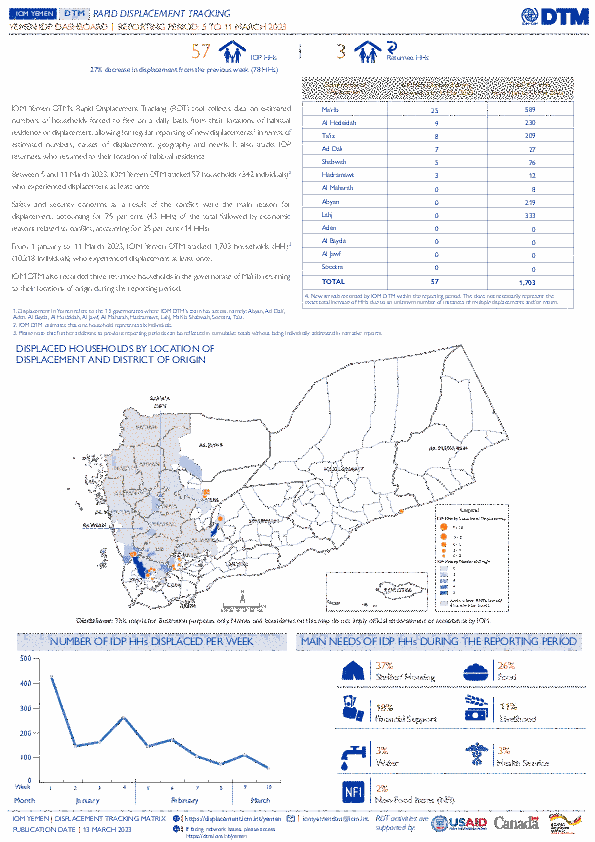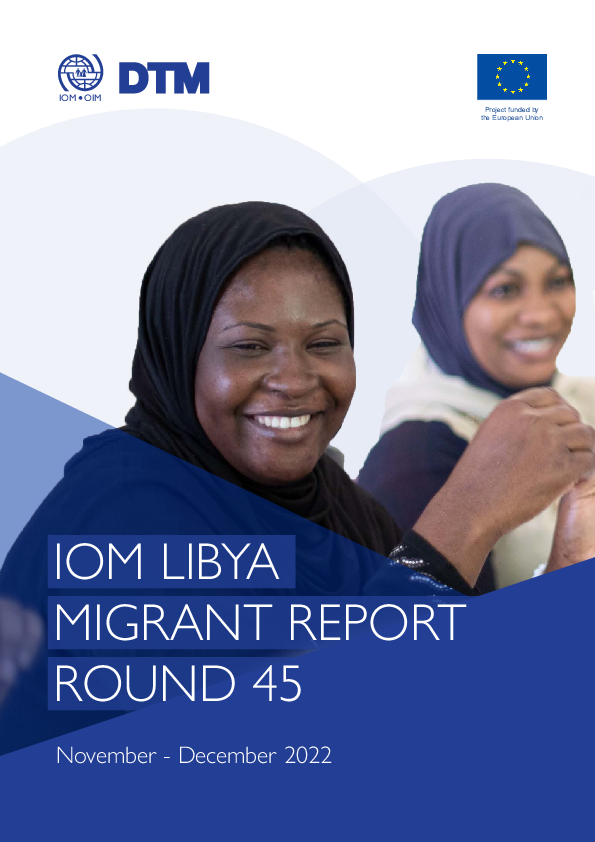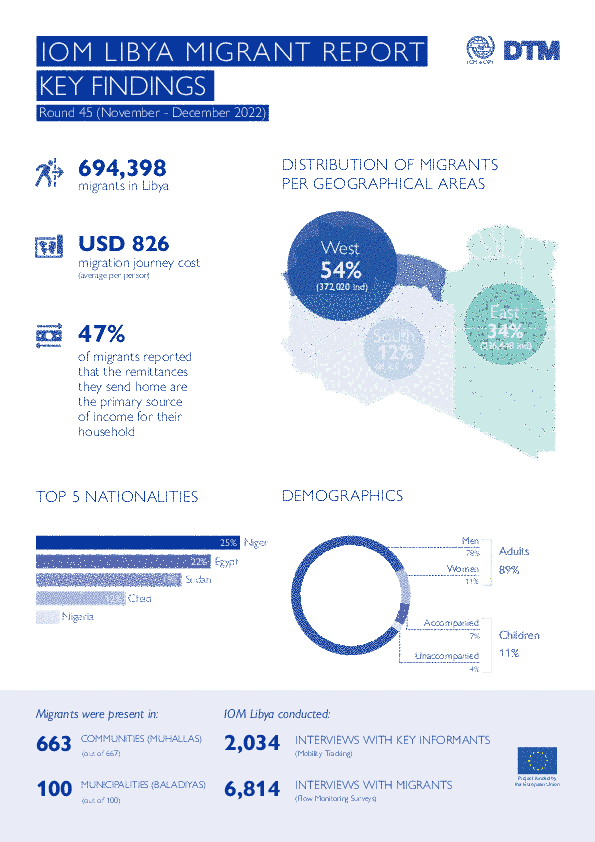-
Countries
-
Data and Analysis
-
Special Focus
-
Crisis Responses
Contact
DTM Yemen, iomyemendtm@iom.int
Location
Yemen
Activity
- Mobility Tracking
Period Covered
Mar 05 2023 -Mar 11 2023
From 1 January to 11 March 2023, IOM Yemen DTM tracked 1,703 households (HH) (10,218 Individuals) who experienced displacement at least once.
-
Between 5 and 11 March 2023, IOM Yemen DTM tracked 57 households (342 individuals) displaced at least once. The majority of people moved into/within the following governorates and districts:
- Ma’rib (25 HHs) – Ma’rib City (22 HHs), Ma’rib (3 HHs) districts. Most displacements in the governorate originated from Sanaa and Dhamar.
- Al Hodeidah (9 HHs) – Hays (9 HHs) district. Most displacements in the governorate originated from Al Hodeidah and Ta’iz.
- Ta’iz (8 HHs) – Jabal Habashi (4 HHs), Al Mudhaffar (2 HHs), Al Maafer (1 HHs) districts. Most displacements in the governorate were internal.
-
The majority of people moved from the following governorates and districts:
- Ta’iz (17 HHs) – Maqbanah (5 HHs), Jabal Habashi (4 HHs), Mawiyah (3 HHs) districts.
- Al Hodeidah (10 HHs) – Jabal Ras (3 HHs), Al Khukhah (3 HHs), Al Jarrahi (2 HHs) districts.
- Al Bayda (5 HHs) – Nati (5 HHs) district.
Population Groups
Survey Methodology
Unit of Analysis Or Observation
Type of Survey or Assessment
Keywords
Geographical Scope
Administrative boundaries with available data
The current dataset covers the following administrative boundaries

Contact
DTM Yemen, iomyemendtm@iom.int
Language
English
Location
Yemen
Period Covered
Mar 05 2023
Mar 11 2023
Activity
- Mobility Tracking
IOM Yemen DTM’s Rapid Displacement Tracking (RDT) tool collects data on estimated numbers of households forced to flee on a daily basis from their locations of origin or displacement, allowing for regular reporting of new displacements in terms of estimated numbers, geography, and needs. It also tracks returnees who returned to their location of origin.
From 1 January to 11 March 2023, IOM Yemen DTM tracked 1,703 households (HH) (10,218 Individuals) who experienced displacement at least once.
Between 5 and 11 March 2023, IOM Yemen DTM tracked 57 households (342 individuals) displaced at least once. The majority of people moved into/within the following governorates and districts:
- Ma’rib (25 HHs) – Ma’rib City (22 HHs), Ma’rib (3 HHs) districts. Most displacements in the governorate originated from Sanaa and Dhamar.
- Al Hodeidah (9 HHs) – Hays (9 HHs) district. Most displacements in the governorate originated from Al Hodeidah and Ta’iz.
- Ta’iz (8 HHs) – Jabal Habashi (4 HHs), Al Mudhaffar (2 HHs), Al Maafer (1 HHs) districts. Most displacements in the governorate were internal.
The majority of people moved from the following governorates and districts:
- Ta’iz (17 HHs) – Maqbanah (5 HHs), Jabal Habashi (4 HHs), Mawiyah (3 HHs) districts.
- Al Hodeidah (10 HHs) – Jabal Ras (3 HHs), Al Khukhah (3 HHs), Al Jarrahi (2 HHs) districts.
- Al Bayda (5 HHs) – Nati (5 HHs) district.
Population Groups
Survey Methodology
Unit of Analysis Or Observation
Type of Survey or Assessment
Keywords
Geographical Scope
Administrative boundaries with available data
The current dataset covers the following administrative boundaries

Contact
iomkyrgyzstan@iom.int
Language
English
Location
Kyrgyzstan
Period Covered
Nov 01 2022
Nov 30 2022
Activity
- Survey
- Flow Monitoring Survey
- Mobility Tracking
- Baseline Assessment
In November 2022, the Mobility Tracking Matrix (MTM) conducted the first round of its Baseline Mobility Assessment in Kyrgyzstan to track mobility, provide information on population estimates, geographic distribution of migrant workers and return migrants, reasons for migration, countries of return and periods of migration. MTM enables IOM and its partners to maximize resources, set priorities, and deliver better-targeted, evidence-based, mobility-sensitive and sustainable humanitarian assistance and development programming. For more information about MTM Kyrgyzstan please visit https://dtm.iom.int/kyrgyzstan
Data on population sizes for the three target population categories is collected by time of mobility, categorizing them yearly for 2020, 2021, and 2022.
IOM works with national and local authorities in order to gain a better understanding of population movements throughout Southern Africa. Through the setup of Flow Monitoring Points (FMPs), IOM seeks to quantify migration flows, trends and routes and to gain a better understanding of the profiles of observed individuals at entry, transit or exit points (such as border crossing posts, bus stations, rest areas, police checkpoints and reception centres). At each FMP, DTM conducts two main activities: Flow Monitoring Registry (FMR) and Flow Monitoring Surveys (FMS). This report is an overview of FMR and FMS data collected from January through December 2021 at the eight migration corridors that were active in 2021.
Inter-regional migration from and within Southern Africa is categorized along the following corridors. The Flow Monitoring Points (FMPs) were set-up in several key transit locations along the corridors to track the movements of passengers:
- Zimbabwe – Botswana (Plumtree)
- Zimbabwe (Mutare) – Mozambique (Manica)
- Zimbabwe (Chirundu) – Zambia
- South Africa – Zimbabwe (Beitbridge)
- Malawi (Mchinji) – Zambia (Mwami)
- Malawi (Karonga ) – United Republic of Tanzania
- Malawi (Mwanza) – Mozambique (Zobue)
- Malawi (Mulanje) – Mozambique
Over the reporting period a total of 430,007 movements were observed across 68 FMPs in the region and a total of 12,881 surveys were conducted at 54 FMPs.

Contact
DTM Uganda, dtmuganda@iom.int
Language
English
Location
Uganda
Period Covered
Dec 01 2022
Dec 31 2022
Activity
- Mobility Tracking
The year 2022, Uganda experienced multi-hazards events that include Natural disasters like drought, floods, landslides/mudslides and heavy storms/hailstorms. And in the month of September, the ministry of health declared the outbreak the Ebola Virus Disease in Uganda. This was also coupled with anthropogenic hazards like transport related accidents, land conflicts and fires.
A total of 171,148 individuals were affected, representing 33,476 households of which 22,456 individuals from 5,935 households were internally displaced by the disasters in 2022. Adults (19-64) were the most affected population group (47%), followed by children under 18 (43%) and the elderly above 64 (10%) in 2022. The most affected districts by disasters include Kisoro, Kasese, Mbale, Katakwi, Kampala, Wakiso and Adjumani.
Natural hazards, mostly floods, heavy storms/hailstorms and landslide combined with mudslides, ravaged the nation in disaster prone districts like Kisoro, Bulambuli, kween, Kasese, Mbale, Amuru among others.
Contact
dtmlibya@iom.int
Location
Libya
Activity
- Mobility Tracking
- Baseline Assessment
Period Covered
Nov 01 2022 -Dec 31 2022
A baseline assessment is a sub-component of mobility tracking. It aims to collect data on IDP, migrant or returnee population presence in a defined administrative area of the country.
Population Groups
Survey Methodology
Unit of Analysis Or Observation
Type of Survey or Assessment
Keywords
Geographical Scope
Administrative boundaries with available data
The current dataset covers the following administrative boundaries

Contact
DTM Libya, DTMLibya@iom.int
Language
English
Location
Libya
Period Covered
Nov 01 2022
Dec 31 2022
Activity
- Mobility Tracking
- Baseline Assessment
IOM Libya’s Displacement Tracking Matrix (DTM) programme identified a total of 694,398 migrants from over 42 nationalities in the 100 Libyan municipalities during Round 45 of data collection (November - December 2022). Consistent with previous reports, the number of migrants in Libya has continued to increase slightly compared to the previous round of data collection (683,813 migrants, Round 44, September – October 2022) in line with a trend that started at the beginning of 2021. The number of migrants in Libya identified during Round 45 is the second largest since DTM started collecting data in 2016, after Round 17 (January 2018) when there were an estimated 704,142 migrants.

Contact
DTM Libya, DTMLibya@iom.int
Language
English
Location
Libya
Period Covered
Nov 01 2022
Dec 31 2022
Activity
- Flow Monitoring
- Mobility Tracking
- Baseline Assessment
This infographic presents the key findings of Round 45 of the mobility tracking component of the Displacement Tracking Matrix (DTM) programme in Libya.

Contact
DTMUkraine@iom.int
Language
English
Location
Ukraine
Period Covered
Jan 01 2023
Feb 28 2023
Activity
- Return Intention
- Mobility Tracking
The Conditions of Return Assessment is a multi-sectoral location-level assessment (MSLA) conducted with local authority key informants at the settlement or city-raion level in areas of return across Ukraine. Data collection for Round 1 took place between the 1 January and 28 February 2023 across 15 hromadas in 6 oblasts. To inform targeted interventions aimed at alleviating the vulnerability that stems from poor physical and social conditions in areas of return, the Conditions of Return Assessment provides granular data on where returns are occurring, where those who have returned are most vulnerable and why.

